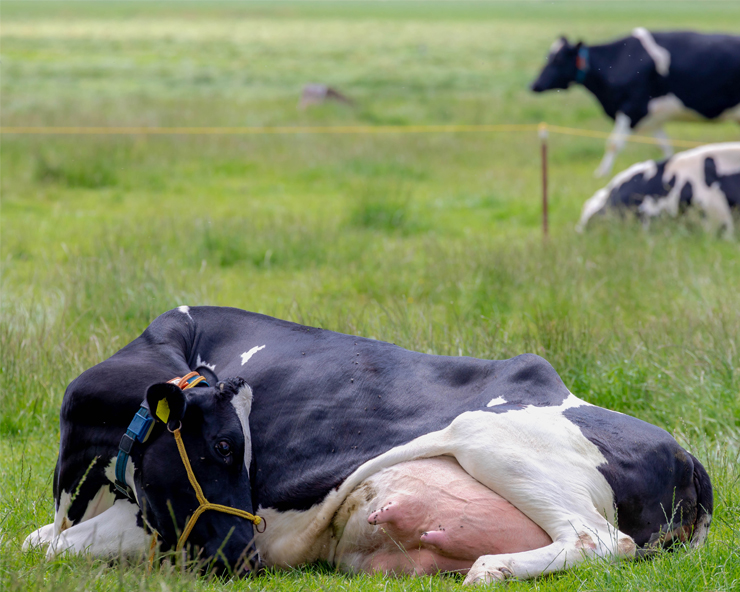One thing no one ever wants to find is a down cow on their farm. Cattle that are too weak and unable to stand can easily become a target for predators, especially out on pasture. Moving quickly and attending to the animal as soon as possible is important.
5 M’s of Down Cows
If you have owned cattle and worked with a veterinarian, you may have heard the phrase “5 M’s of Down Cows”. These five categories are mastitis, metritis, metabolic, musculoskeletal, and mystery.
- Mastitis is an infection of the udder that starts with inflammation leading to decreased milk production. Left untreated, toxins can travel to the bloodstream, and she can become too ill to stand. These infections often occur soon after calving. Injury to the udder, poor hygiene, or physical trauma can also contribute to mastitis.
- After calving, metritis can cause a down cow. Metritis is an infection of the uterus that can, similarly to mastitis, have toxins enter the bloodstream. This can cause a cow to become too weak. Having clean calving pens and a well-balanced diet can help protect cows against metritis.
- Metabolic diseases can also contribute to down cows, especially when cows aren’t getting the nutrients they need. Ensuring that sufficient planning goes into the diet, especially during the winter, can reduce the instance of the disease in your herd.
- Sometimes, cows may deal with fractures, calving paralysis, or an injury affecting nerves. Time often plays a factor in determining how severe the damage is. Taking the time to evaluate the cow with your veterinarian can help determine the severity of the injury.
- While it can be frustrating, it is not always possible to find a cause. This often occurs because a combination of causes is not evident. Even when a cow is alert and eating, serious conditions may prevent her from getting up. Never use forceful methods to get a cow to stand.
When You Have A Down Cow
- Attend to her quickly. Every day a cow is down reduces the chance of her recovery. If she is dealing with a serious injury requiring euthanasia, acting quickly will also reduce her suffering.
- Roll her to her chest to avoid the chance of bloating. Bloating can also be rapidly fatal. Using hay bales to prop her up can reduce the chance of nerve damage to her legs and back on the side she lays. By rolling her to opposite sides a few times a day, you can help maintain circulation and reduce additional injury.
- Call your veterinarian. Making a proper diagnosis and early treatment will increase her chance of recovering. If you cannot determine whether she can recover, your veterinarian can provide another perspective and help determine early whether euthanasia is the best option.
- Evaluate her location. Is she in a dry, protected area? If not, it may be in her best interest to move her.
- If you need to move her, use safe moving methods. Sleds, harnesses, and bucket loaders are all acceptable moving devices. Be aware of cow comfort and use multiple people to help coordinate moving the cow. Avoid trying to move the cow by dragging or lifting the cow by her head or neck which can cause more damage.
- Provide fresh water and feed. Make sure feed and water pans are shallow enough to be easily accessible.
- Check on the cow frequently. If you see improvement after 24 hours, and the cow is eating and alert, she may get better. If she is in obvious pain and is struggling, euthanasia may be the best option.
If you have more questions about down cow care, talk to your local veterinarian or check out the resources listed below.
Resources:
Bovine Veterinarian: Do’s and Don’ts for Down Cow Care


Good article! A cow unable to get up is a true emergency and unfortunately can be a frustrating situation for all involved. Call for veterinary help sooner rather than later – they (vets) can help with both treatment and decision making.
The resources listed here are all good.